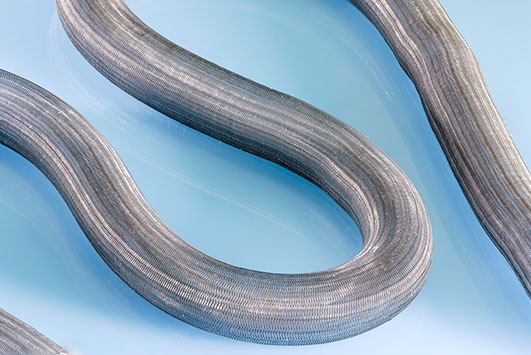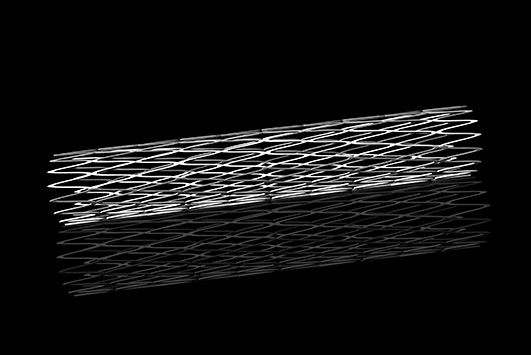
When it comes to treating and managing neurovascular conditions and performing neurointerventional surgeries, the size and precision of a device are imperative.
![]()
Biomedical Textiles for Neurovascular Applications
When it comes to treating and managing neurovascular conditions and performing neurointerventional surgeries, the size and precision of a device are imperative.
![]()
Today’s neurovascular procedures have been revolutionized by less invasive surgical approaches and lower profile delivery systems leveraging micro-catheters. The incorporation of implantable biomedical textile components allows medical devices to be smaller, lower profile, compressible and flexible enough to be adeptly guided through the complex yet delicate network of blood vessels in the head and neck, while still able to perform their intended, often life-saving function.
Braided, knitted and woven biomedical textiles are now being used in a wide variety of neurovascular applications, ranging from preventing ischemic strokes by removing debris in the vessels; to treating aneurysms and brain hemorrhages; to improving patient outcomes by removing thrombus after a stroke. Implantable fabrics can be shaped into tubular and multi-lumen structures, tethers or sutures.
Textiles incorporating metal alloys such as Nitinol are ideal for neurovascular devices due largely to two unique properties: shape memory effect (SME) and superelasticity. Shape memory allows nitinol to undergo deformation at one temperature, stay in its deformed shape when the external force is removed, then recover its original shape upon heating above its “transformation temperature”. Superelasticity means it can undergo large deformations and immediately return to its undeformed shape upon removal of the external load¹.
Biomedical textiles can be used for less invasive neurovascular procedures including:
- Intracranial aneurysm repair and occlusion
- Flow diversion
- Ischemic clot retrieval/ thrombus retrieval
- Neurostenting
- Peripheral nerve conduit
- Nerve regeneration (sheaths)
Key benefits of textiles
- Minimally invasive
- Radial reinforcement and expansion
- Compaction
- Flexibility
- Porosity
- Shape transformation capabilities to allow for low-profile delivery
When biomedical textile engineers work closely with medical device OEMs, they can add a greater degree of innovation and efficacy to neurovascular medical devices by creating structures better aligned with how the device needs to perform today, as well as how it must function in the body over time.
Cortland Biomedical is trusted by leading medical device OEMs to enable smaller, lower profile neurovascular devices by designing and engineering braided, woven and knitted biomedical textiles fit-for-purpose.





Today’s neurovascular procedures have been revolutionized by less invasive surgical approaches and lower profile delivery systems leveraging micro-catheters. The incorporation of implantable biomedical textile components allows medical devices to be smaller, lower profile, compressible and flexible enough to be adeptly guided through the complex yet delicate network of blood vessels in the head and neck, while still able to perform their intended, often life-saving function.
Braided, knitted and woven biomedical textiles are now being used in a wide variety of neurovascular applications, ranging from preventing ischemic strokes by removing debris in the vessels; to treating aneurysms and brain hemorrhages; to improving patient outcomes by removing thrombus after a stroke. Implantable fabrics can be shaped into tubular and multi-lumen structures, tethers or sutures.
Textiles incorporating metal alloys such as Nitinol are ideal for neurovascular devices due largely to two unique properties: shape memory effect (SME) and superelasticity. Shape memory allows nitinol to undergo deformation at one temperature, stay in its deformed shape when the external force is removed, then recover its original shape upon heating above its “transformation temperature”. Superelasticity means it can undergo large deformations and immediately return to its undeformed shape upon removal of the external load¹.
Biomedical textiles can be used for less invasive neurovascular procedures including:
- Intracranial aneurysm repair and occlusion
- Flow diversion
- Ischemic clot retrieval/ thrombus retrieval
- Neurostenting
- Peripheral nerve conduit
- Nerve regeneration (sheaths)
Key benefits of textiles
- Minimally invasive
- Radial reinforcement and expansion
- Compaction
- Flexibility
- Porosity
- Shape transformation capabilities to allow for low-profile delivery
When biomedical textile engineers work closely with medical device OEMs, they can add a greater degree of innovation and efficacy to neurovascular medical devices by creating structures better aligned with how the device needs to perform today, as well as how it must function in the body over time.
Cortland Biomedical is trusted by leading medical device OEMs to enable smaller, lower profile neurovascular devices by designing and engineering braided, woven and knitted biomedical textiles fit-for-purpose.







